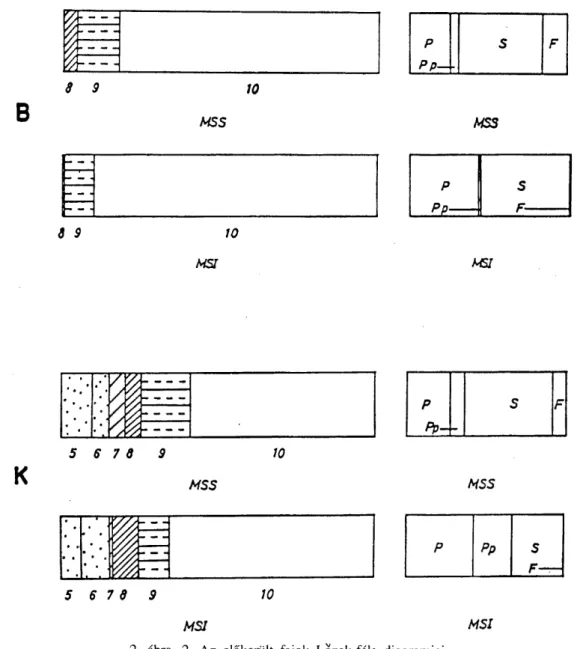Investigation with the I C L 4 computer system on the population of Dreissena mussels from the upper sediment layer of Lake Blatno.-Ann. Abstract: As one of the results of the revision of the Pleistocene Vertigo material of the Hungarian Pleistocene formations, this article presents a review of 3 species that were hitherto unpublished or questionable. It was first recorded in the literature in the list of Pleistocene species (K ro - lopp, E. 1982-83), where it was placed on the basis of the material collections of the Hungarian Geological Institute.
This difference in the distribution of the two species can be attributed to their slightly different ecology, on the basis of which we will consider V. We emphasize that, based on the studies carried out on Hungarian Pleistocene material, Vertigo geyeri and the species V: genesii can be separated from each other well (Krolopp, E.-Sümegi, P. 1992 a). History of the Upper Pleistocene evolution of Hajdúság (Hungary) d. gion, based on stratigraphic, paleontological, sedimentological and geochemical research.
Paleoecological construction of the last period of the Upper Würm in Hungary based on malacological and radiocardon data.
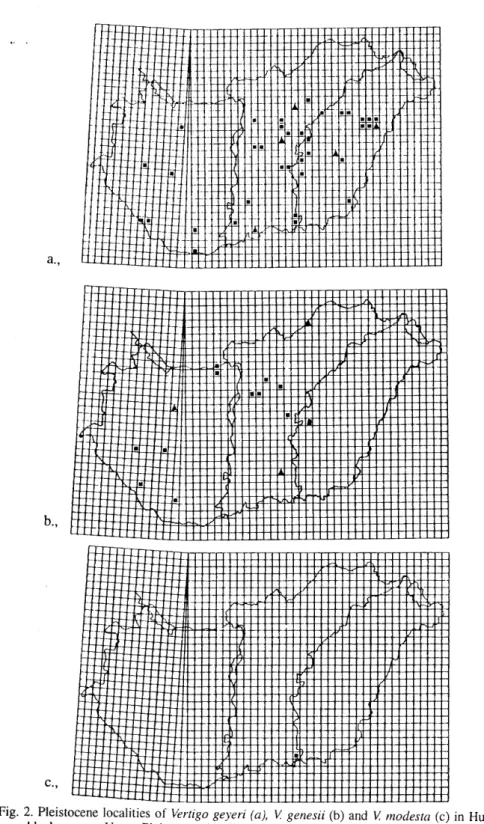
Main features of the development of the Hungarian Holocene Mollusc fauna
Vitrea subrimata Oxychilus inopinatus Oxychilus draparnaudi Daudebardia brevipes Daudebardia helenae Trichia hispida Semilimax kotulai Perforatella vicina Monacha cartusiana. Among the recent mollusk species, Helicella obvia is so far the only one not known from Holocene sediments of mid-elevation mountain ranges. Development of the Holocene mollusc fauna in the Hungarian subsidized zones During the author's investigations, 33 species have been found.
Species that appear only in a certain period of the Holocene from a significant part of the fauna (21 species). Quartermalakologische Untersuchungen holozäner Sediments in nor. 1987): Evolution of the mollusc fauna of the Hungarian highlands in the Holocene (in: Pécsi, M.-Kordos, L. Holocene Environment in Hungary).-Geogr. Examinations on the faunal history of the Hungarian Holocene molluscan fauna (Characterization of the succession phase).-Fol.Hist.-nat.Mus.Matr.l6:13-28.
Kvartermalakológiai vizsgálatok Somogy megyében I
Bathyomphalus contortus Bithynia tentaculata Gyraulus crista Hyppeutis companatus Lymnaea peregra Lymnaea truncatula Physa fontinalis Planorbarius corneus Viviparus vontectus Daudebardia rufa Vertigo pusilla Vallonia ribata Vallonia pulchella Vertigo pygmaea Cochlicopa lubrica Slimacidae indet Clausiliidae indet Acroloxus lacustris Bathyomphalus contortus Bithynia tentaculata Gyraulus crista Hyppeutis companatus Lymnaea peregra Lymnaea truncatula Physa fontinal is Planorbarius corneus Viviparus vontectus
W Daudebardia brevipes Daudebardia ruta Vertigo pusilla 5. Planorbis planorbis Segmentina nitida Valvata eristata Vallonia enniensis Vertigo antivertigo Zonitoides nitidus W Daudebardia brevipes Daudebardia rufa Vertigo pusilla 5. Planorbis planorbis Segmentina nitida Valvata eristata Vallonia enniensis Vertigo antivertigo Zonitoides nitidus
A New Biotope of Chilostoma banaticum (Rossmässler, 1838) in Hungary
The places near the Tisza River are on the floodplain (between the dam and the river), and although the third, M á l y v á d Forest is outside the dam, it is used as an emer. Fossils, subfossils and recent occurrences of species are found on the banks of rivers that take their sources in Transylvania and flow through the Great Hungarian Plain (Tisza, Maros, Fekete-Körös). There are no records of the occurrence of the species in the Great Hungarian Plain from the Pleistocene, but it was found in Holocene sediments near the banks of the former bed of the Fekete-Körös River (Domokos T. 1986).
But in our opinion, the shell parameters of Chilostoma banaticum do not depend on the annual precipitation and on the changes in the average annual temperature (Bába, K. We can only assume - on the basis of quaternary malacological and pollen analytical studies carried out in the region - that it could happen in the last 7000 years, supposedly before X V I I I. Recently, this endemic species in the Carpathians can only be found in the Hungarian Great Plain only in the soft and hardwood gallery forests, near the rivers coming from Transylvania.
The newly found population near Tiszabecs confirmed the ideas of Hungarian malacologists about the species, its migration and decline due to human activities.
On the identity of Sphaerumbonella brunelli Coen, 1933 (Mollusca, Bivalvia, Galeommatidae)
A note on the systematics and distribution of „Cocculina" simplicior Melvill, 1912
Mollusca, Gastropoda, Lepetellidae)
General distribution: G u l of Oman and G u l f of Aqaba, but probably elsewhere in deep water in the NW corner of the Indian Ocean. Remarks: Shells of Lepetella simplicior appear to differ from Lepetella laterocompressa only in being slightly more slender. The shape of the shell, especially its base, depends very much on the shape of the subsoil on which it lives.
Although Panetta (1973: 1) considers Lepetella laterocompressa to be a cosmopolitan species, its distribution records are limited to both sides of the Atlantic and the Mediterranean. As long as the fauna of Lepetella simplicior remains unknown and cannot be compared with that of Lepetella laterocompressa (Warén, A. Descriptions of thirty-three new species of gastropoda from the Persian Gulf, G u l of Oman and North Arabian Sea.
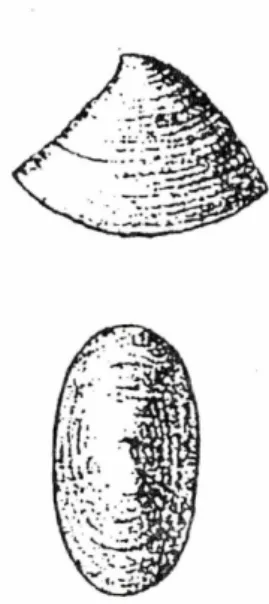
A landsnail in a faecal pellet of the snake Eirenis rothi Jan, 1865
Mollusca, Gaatropoda - Reptilia, Ophidia)
A Szigetbecsei-holtág malakológiai állapotának alapvetése
A vizsgált terület vegetációja ß-mesosaprobe szaprofitán alapul: ceratophyllum demersum, myriophyllum spicatum (Gulyás, P. 1976), fél-eutotrofikus, eutotrophic, a trophicics alapján: Myriophyllum spicatum, Phragmites kommunis, typha lavativyfolcs (typhfa lava lava lava lava lava lava lava lava lava-lava lava-lava-lava-lava-lava-lava-lava-lava-lava (typholic lava lava lava cmolc.) alii., 1986) a következő fajokat tartalmazza.
The effect of becoming waterless and experiments of livingplace reconstruction on Mollusca living in the
The effect of going without water and experiments with the reconstruction of living places on the Mollusca that live in. In the drilling samples I have found pieces of death snails (Chondrula tridens, Vallonia pulchella), and the water - Valvala pulchella is only known from drilling in this area. The cumulative presentation in large numbers of the large Lymnaea stagnalis and Lymnaea peregra is very interesting in the open water lake.
Distribution of these species is insular or accidental unusual, so that the quantity, number and distribution of the species are considerably less in the digestive tract than in the (Fehérszék). The digestive tract is the richest in species (9), but remarkably the interspecific characteristics of the species are the least favorable. There are 6 species in the lake marked "A", most in the northeast corner of the reeds near the receiver mouth. Many individuals fall mainly from adults of Lymnaeas, much less in the case of Planorbarius corneus. The most individual specimens of Anisus spirorbis and Planorbis planorbis are going through an unfavorable period.
A channel flows between water storage number I and the lake, marked "A", and in the 2-3 cm deep water of the bow these individuals gathered in large numbers during the dry period. Now it is widespread throughout the lake, marked 'A', and its characteristics are only affected by the pH value and Na2C3 amount of water. There are clear ecological refugiums in the case of other species, for example the Segmentina nitida, Planorbarius corneus in the northwestern reed of the lake, signed "A", the Lymnaea peregra in a lake dug hole next to the dams, the Lymnaea stagnalis and the Planorbis planorbis in the vicinity of the water storage opening.
In the reeds found in the northeastern part of the lake, the biomass value is greater. Here, in open water, the value of snail biomass was much higher than in reeds. In reeds and in deep water, large species grow quite well.
Snail biomass is extremely low and insignificant in open water, reaching less than a fiftieth of the F e hér s zék's. In the salt lakes of Upper K i s k u n s á g, the extremes of snail biomass are determined by the flora and the chemical compound of water. p r o d u c t i o n The production of snail species in saltwater:.
Az ellenőrzött területen a műhabarcsok (Szarvasi, Halászteleki, Aranyosi) mellett az egykori természetes habarcsok romjai is jól felismerhetők. Mély fekvésű, mocsaras terület Nagy- és Aranyosi hátország között, sásokkal és esetenként Carex, Phragmites és Thypha populációkkal. Csak a védett területen előforduló fajok: Acroloxus lacustris, Anodonta cygnaea, Carychium minimum, Monaclta cartusiana, Vallonia pulchella, Vertigo pygmaea.
A Vertigo pygmaea élő egyedei bizonyítják, hogy az Alföldön nemcsak az erdők aljnövényzetében (Kovács, Gy., 1980), hanem a nyílt ültetvényes, nedves réteken, csatornapartokon és mocsarakban is megtalálható. 1980-ban megjelent alapművében az Anisus vortex és a Physa fontinalis egyetlen lelőhelyét említi, az Anisus vorticulus pedig egyáltalán nem szerepel fajlistáján. Az elmúlt évek gyűjtései azonban bebizonyították, hogy nemcsak a hullámmezőnek, hanem a mentett oldalon elhalt vízfolyások mocsaras és száradó biotópjainak is in situ eleme (Kovács Gy.-Domokos T. 1987). ).
A fajjegyzékből megállapítható eltérések mellett a gyakori fajok gyakoriságát is közölni kell. méretéről, illetve a kimutatható morfológiai eltérésekről is. 1964), időszakos mocsarak lakója. Míg a Planorbarius corneus nagytestű - kiszáradás után is élő - példányai az árapály területére alkalmasak, addig a főalaktól eltérő / banatica a megőrzött oldal biotópjaira. A Planorbidae másik nagyon strapabíró nagy reprezentációja a balra fordult Pla. E fajnak a feljegyzett lelőhelyen talált egyedei a fő alaktól eltérő morfológiájúak.
Mert a testforma dombosabb és laposabb oldalát zsinór alakú gerinc választja el. a koncertek címerének köszönhetően a hajó orra a ferde ellipszisben szöget vesz be, vagy más módon. Ez az a bélyeg, amely nem, vagy alig látható a megőrzött területen található biotópok egyedein. Ezt a nedvességet kedvelő, de kifejezetten párás ökotípust Kovács Gy. már leírta. olyan fajjal van dolgunk, amely elkerüli a vízi biotópokat. A túlnyomóan fenéklakó Valvata piscinalis a gát mindkét oldalán csak egy-egy példányt képvisel. 1964) szintén két alcsoportba (S és F) sorolja a vízi fajok csoportján belül.
Az egyes biotópok fajösszetételének összehasonlításához az általánosan használt Sörensen-féle hasonlósági együtthatót vettem alapul.
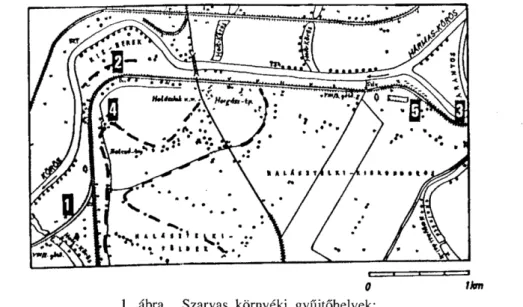
Kiszáradó láprétek, alföldi mocsárrétek, sziki sásrétek csigaegyütteseiről
A csigákat a z talált fajok összes egyedszámából számított dominancia és az egyes kvadrátok gyakorisági értékeinek átlaga alapján kapott állandósági százalék alapján választottuk ki. Az emberi beavatkozás hatására fokozatosan növekszik a szaprofág táplálkozási típus aránya, ez a bagiszegi és landori erdős területeken történt, részben a Lymantria gradáció, részben a törzsszelekciós ritkítás miatt (Bába, K.
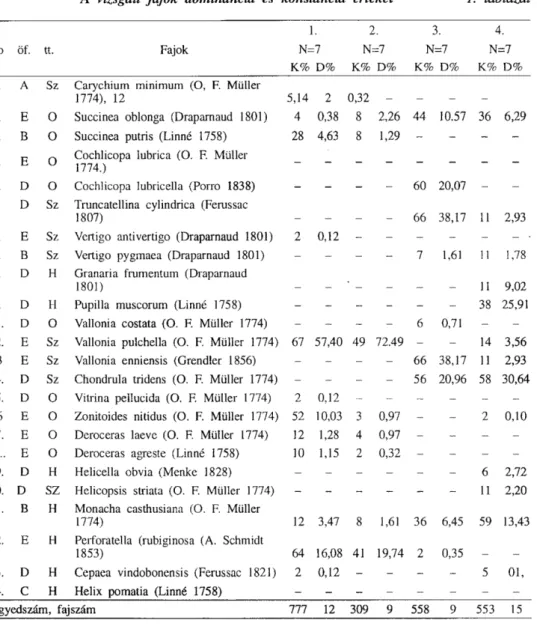
Előzetes adatok a barabási Kaszonyi-hegy (ÉK-Magyarország) Mollusca faunájához
Sőt, az állatvilágból kiemelhető a Vitrea diaphana (Studer, 1820) és a Balea stabilis (C. Pfeiffer, 1828) fajok jelenléte, mivel ez az első gyűjtemény az Alföld területéről. A Mollusca faunában igen jelentős része található az erdei környezetet igénylő faunaelemeknek, a Kárpátok (Balea stabilis, Perforatella vicina) és Közép-Európa hegyvidéki területein (Vitrea dia. phana, Clausilia pumila) elterjedt fajok. A Tdio tomentosae-Quercetum dalechampii-cerris társulásban riolitsziklán, száraz völgyben több kárpáti elterjedésű molluscafaj is megtalálható.
Ti Balea stabilis (C. Pfeiffer, 1847) ken Vitrea diaphana (Studer, 1820) ket sumagmamano kadagiti kadawyan a sebbangan idiay Ginget ti Magyar Nagya. Deskribiren dagiti autor ti agdama a malacofauna ti Kaszony Hill iti asideg ti purok ti Barabás, a masarakan iti amianan a daya a paset ti Great Hungarian Plain. Iti maysa a Tilio tomentosae-Quercetum dalechampii-cerris a pagtakderan iti kama ti rhyolite iti igid ti maysa nga astatiko a ginget ti karayan sumagmamano a sebbangan ket naipalpalagip a dagitoy ket sapasap a nailasin babaen ti heograpiko a pannakaiwaras ti Karpato.
Also, the first data on the occurrence of Balea stabilis (C. Pfeiffer, 1847) and Vitrea diaphana (Studer, 1820) in the Great Hungarian Plain are presented.
Adatok a meztelencsigák gombatáplálékáról
1992-ben a közelmúltban az Upponyi-szorosban végzett faunakutatások kapcsán (Fű . köh, L .. 1993) három mintaterületről elemeztük a Zebra törmelék anyagának hosszára vonatkozó adatokat ( U - l , U—3, U - 6 ) 100 véletlenszerűen kiválasztott személy alapján .
Mollusca-gyűjteményem anyagáról
A Hansági Múzeum (Mosonmagyaróvár) Mollusca gyűjteménye
